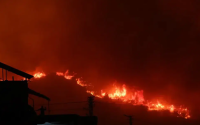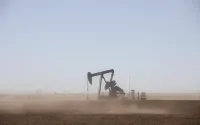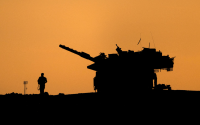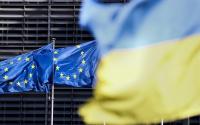2 August 2006Ghaith Abdul-Ahad
Three days ago, next to the gutted and destroyed house in Qana, seven bodies lay covered with bedsheets, a blanket and a prayer mat. One small arm stretched out from under the sheets; thin, the arm of a little girl, a piece of cloth like a bracelet wrapped around the wrist. As bodies were loaded on the stretcher, I saw another dead girl; she was dressed in a black shirt with a coloured scarf wrapped loosely around her head. Her face was swollen.
In some ways I was relieved. The rumour we had heard in the hotel in Tyre was that at least 40 people, half of them children, had been in the house in Qana when it was bombed by Israeli planes, and here I was an hour later, with Red Cross workers and others running up and down, and all I could see was the bodies of two girls and five adults.
It's weird, the things that make you feel better in the south of Lebanon, but seven dead instead of 40 gave me a sense of relief.
But even as I stood there registering that emotion, hellish scenes were unfolding. Four medics carried a little boy by on an orange stretcher: he was perhaps 12 years old, dressed in black shorts and a white T-shirt with a coloured motorcycle on it. His arms were stretched behind his head, but apart from the bruises on his face and the swollen lips, he looked OK. For half a second I told myself, as I tell myself every time I see death, that he was just sleeping, and that he would be fine. But he was dead.
Then came two more boys in the arms of the rescuers. One of them, the younger, around eight years old, had his arms close to his chest, his nose and mouth covered with blood. The elder, around 10, had dirt and debris in his mouth. Their slight bodies were put on a blanket, the head of the younger boy left resting on the shoulder of the elder, then four men carried the blanket off, stopping twice to rest as they took them away. The bodies of the boys were piled with other corpses in the back of an ambulance.
Two more small dead boys followed them. The medics were running out of stretchers, so they piled the corpses of the boys on one orange stretcher. One of the kids was slightly chubby; he was wearing a red T-shirt and shorts. His head rested on the lap of the younger, who was about six years old; both had the same exploding lips, covered with blood and dirt. It was obvious to everyone that these boys were not sleeping.
Then another child was pulled from under the rubble, and another followed, and then another. You go a little crazy when you see little body after little body coming up out of the ground. I looked around me and all I could see in the house was the detritus of their short lives - big plastic bags filled with clothes, milk cans, plastic toys and a baby carriage.
By three in the afternoon, when the corpse of a one-year-old boy was pulled from the rubble, he looked more like a mud statue than a child. The medics held him high above their heads, clear of the rubble. The faces of the rescue workers said everything that needed to be said.
What is obvious to everyone covering this conflict is that children are bearing the brunt of it. The few official figures collated so far seem to support this. Unicef says that 37 of the 60 dead in Qana on Sunday were children, and everywhere you go, it seems that it is the children who are being killed, injured and displaced. Yesterday the Lebanese government said that of the 828 of its civilians killed in the conflict so far, around 35% have been children - that's around 290. Unicef also estimates that about a third of the dead have been children, although it bases that figure on the fact that an estimated 30% of Lebanon's population are children, rather than any actual count of the dead. There are no official figures yet for the number of wounded children, but they will certainly exceed the number killed; as for those displaced, Unicef says that 45% of the estimated 900,000 Lebanese to have fled their homes are children.
Aid agencies believe that the reason children are suffering so much in this conflict is because of the big families that are traditional in south Lebanon. "You are not talking about nuclear families, you are talking about families huddling together with four, five or six children. Inevitably, a high percentage of children are killed," says Anis Salem, a Unicef spokesman. "We estimate that before Qana, 30% of the deaths were children, but it is a very fluid situation and that figure can quickly become redundant."
It is not just a matter of many children huddled together, of course: with numbers come all sorts of problems. If an air raid is coming, and you are running, how many children can you pick up and carry with you? How many do you have to leave behind?
Children often suffer most in wars like this - wars in which civilians suffer heavy casualties. They are weaker, they may be too small to run or walk, they may suffer more on long journeys by foot. And as Amelia Bookstein, head of humanitarian policy at Save the Children, points out: "Children who are wounded, separated from their families, or traumatised, may be too frightened or unable to flee their homes."
There are the official statistics, and then there are the children, who seem to be everywhere in the heart of this conflict, all with their own, painful, awful stories. A week ago I met Abbas Sha'ito, a chubby 12-year-old boy in a bright orange T-shirt who was sitting on the side of a road south of Tyre, blood covering his face, his T-shirt torn by the bomb that had hit the minivan he had been in. He and 17 others had been inside; his mother, brother and aunt were all injured, moaning and in agony a few feet away. Inside the minivan remained the headless corpse of his uncle, and the bodies of his grandmother and another man who had been fleeing with them.
Abbas was weeping, and had an arm round his mother, who seemed to be fading fast: she was injured in the chest and head, and one of her arms was almost severed at the bicep. "Don't leave me, mother," the boy wept. "Don't go, don't go."
It was clear that his mother believed herself to be close to death. "Take care of your brothers and sisters," she said to Abbas.
"Don't leave me," Abbas kept saying.
"My purse is under me. There is money, take care of it," his mother said; as she did, her head began drooping, and Abbas screamed, and a medic rushed in: "Don't cry, don't cry, she will be OK. Just keep talking to her," the medic said.
As it is, Abbas's mother is still alive, although still in intensive care, but Abbas was not to know this then. He buried his face in his hands and wept, while his brother Ali stood nearby, one hand bandaged and his eyes on the horizon.
Last Wednesday, in a hospital in Tyre, I met Samah Shihab, a seven-year-old girl with beautiful long eyelashes from the hamlet of Mlooka near Tyre. She was in the yard of her house with her two brothers, aged four and nine, and her 14-year-old sister, when a shell fell. "I was playing with my sister and brothers when the rocket came," said Samah. "They started screaming and crying. There was pressure in my ears and my hands and legs were all in blood. I was scared. My brother was screaming and I was scared." According to her doctors, Samah, who was badly burned and needs skin grafts on her legs, is unlikely to walk again.
On Monday I met Ali (he didn't give me a second name), who is nine and had been hiding in the basement of his house, along with his aunts, his grandmother and an uncle with learning difficulties, for 20 days in the village of Bint Jbeil. While the family hid below, war raged above: the village has suffered the heaviest shelling of anywhere in the south of Lebanon, as well as intense street battles between Israeli soldiers and Hizbullah fighters. When Ali emerged from the basement on Monday, during a brief halt to the aerial bombardment, he was visibly frightened and shocked, and seemed unable to recognise his surroundings.
As he made his first steps on the big chunks of rubble and concrete strewn everywhere, clutching a bottle of water in one arm and a blue bag in the other, he began shaking and crying. His grandfather, who was leading him through the rubble, collapsed in the shade of a doorway, and Ali and other family members continued their walk to the Red Cross vehicles - parked a kilometre away, at the edge of the village, beyond the edge of the vast and almost impassable rubble field - without him. I walked with them.
As we walked, jumping from one boulder to the other, Ali said: "My father and mother went with my other brothers and sisters to another town. They said they will come and get me when the bombs stop."
In the scorching sunshine above, Israeli jets were flying, their sound mixed with that of the drones. Suddenly a thud came from the hills and Ali froze. "They are going to bomb again!" He started to cry. "Why are the Israelis hitting us? Do they hate us? My cousin Mahmoud called me on the phone and he told me that the nuclear bombs are really big. Are they as big as these rockets?" It's hard to convey quite how shocked, perhaps quite literally shell-shocked - this little boy was. He was almost delusional.
We reached the town square. There was a large, deep crater on one side of it, and a half-destroyed petrol station on the other. Burnt-out cars lay flipped over on to their sides. A few hundred metres later we had to stop for a rest. Ali opened his blue bag and got out a small green bottle of mineral water. It had only a few centimetres left, but he sipped some and passed it to me. I was about to throw the bottle away when he said, "No, no, this is my charm - it's green, the colour of Imam Hussein." (Imam Hussein was the grandson of the prophet Muhammad; he is central to the Shia faith, and a great symbol of martyrdom.)
A few hundred metres further on we reached the Red Cross ambulances. Ali squeezed in with his aunts and other women and children; they were to be taken to the displacement centres in Sidon and Beirut. Ali, it turned out, was fortunate. As I left town, I saw, all along the road, children and their families who had been forced to walk to safety. One father was pushing a wheelbarrow with four young children inside.
In another hospital in Tyre, which has seen 120 injured and 35 dead so far, I meet the young son of the head of the hospital. Muhammad Najem, 11, spends his days inside where it's safe, because a week ago a car was hit by a missile on the road directly outside the hospital. Muhammad draws on a computer: his latest drawing is of Hizbullah fighter. Next to the fighter is a star of David stabbed with a dagger - blood drips down into a vat full of blood marked "Hell".
His elder brother Ali Najem, a fourth-year medical student in his 20s, is rueful. "The Israelis are planting very bad hatred in the children against Israel," he says. Ali has spent the past three weeks documenting the stories of the children who have passed injured or with their injured families through his father's hospital. He particularly remembers one boy, aged about seven, who was caught in a convoy that was hit in the first days of the bombing. This boy described to him, quite calmly, "as if it were a cartoon", how a baby from the car in front of them was ejected out of the window when the vehicle was hit. The boy's father had been killed at the scene.
Ali also talks about the impact on women delivering babies in the midst of conflict. In the first week of the war one of them named her new son Intisar, which means victory. In the past week, two new names have been given to newborns at this hospital: "Wahid, which means 'the lonely', and Dayaa, which means 'the lost'." The woman who gave birth to Dayaa did so alone, having been separated from her husband somewhere in the Bekaa Valley. Ali says that she became disturbed, and called out to her husband: "If you don't come and take me out of this place, I will put myself under these bombs and kill myself and the baby." For newborns, as well as for the older children, the scars of this war are going to take a long time to fade.






